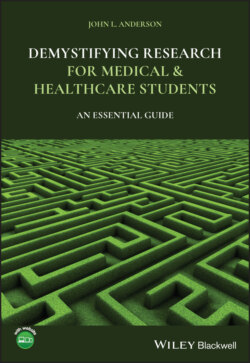Читать книгу Demystifying Research for Medical and Healthcare Students - John L. Anderson - Страница 35
Using Yourself as a Guinea‐Pig
ОглавлениеIn 1882, the German physician and microbiologist identified the bacteria which caused tuberculosis and cholera. Renee Dubos, a microbiologist who specialised in the study of tuberculosis, and one of my favourite ‘Great Thinkers’ about health and medicine, described how Koch injected tuberculin into his own arm and suffered a very serious reaction which showed that he had himself been infected with TB in the past, but had never had clinical tuberculosis. He later discovered the causative agent of cholera – Vibrio cholerae. Max Joseph von Pettenkoffer was a Bavarian chemist and hygienist who was an anti‐contagionist – he did not believe that (very new) idea that bacteria caused diseases like cholera (Figure 2.4). As Dubos recounts:
Around 1900 Pettenkoffer in Germany and Metchinoff in France, with several of their associates, drank tumblerfuls of cultures isolated from fatal cases of cholera. Enormous numbers of cholera vibrios could be recovered from their stools; some of the self‐infected experimenters developed mild diarrhea, but the infection did not result in true cholera. More recently human volunteers were made to ingest billions of dysentery bacilli under conditions assumed to be optimal for the establishment of infection. Enteric capsules full of feces obtained directly from acute cases of bacillary dysentery in man were used as additional experimental refinements to increase the chances of establishing the disease. Yet only a few of the volunteers developed symptoms referable to dysentery and most of them remained unaffected by the experimental infection.
FIGURE 2.4 Max Joseph von Pettenkoffer.
Source: GL Archive / Alamy Stock Photo.
The fact of the matter is that Pasteur and Koch did not deal with natural events, but with experimental artifacts. The experimenter does not reproduce nature in the laboratory. He could not if he tried, for the experiment imposes limiting conditions on nature; its aims are to force nature to give answers to questions devised by man. Every answer of nature is therefore more or less influenced by the kind of questions asked.
The art of the experimenter is to create models in which he can observe some properties and activities of a factor in which he happens to be interested. Koch and Pasteur wanted to show that microorganisms could cause certain manifestations of disease. Their genius was to invent experimental situations that lent themselves to an unequivocal illustration of their hypothesis – situations in which it was sufficient to bring the host and parasite together to reproduce the disease. By trial and error, they selected the species of animals, the dose of the infectious agent, and the route of inoculation, which permitted the infection to evolve without fail into progressive disease. Guinea pigs always develop tuberculosis if tubercle bacilli are injected into them under the proper conditions; introduction of sufficient rabies virus under the dura of dogs always gives rise to paralytic symptoms. Thus, by the skilful selection of experimental systems, Pasteur, Koch, and their followers succeeded in minimising in their tests the influence of factors that might have obscured the activity of the infectious agents they wanted to study. This experimental approach has been extremely effective for the recovery of agents of disease and for the study of some of their properties. But it has led by necessity to the neglect, and indeed has often delayed the recognition, of the many other factors that play a part in the causation of disease under conditions prevailing in the natural world – for example, the physiological status of the infected individual and the impact of the environment in which he lives.
(Dubos 1959)
DO NOT TRY THIS AT HOME! What Dubos has very eloquently illustrated is the difference between the necessary factors which need to be present to cause a disease – the bacilli and the host – and the sufficient factors required to lead to the onset of the disease – such as personal, physiological, nutritional, environmental factors, etc.
